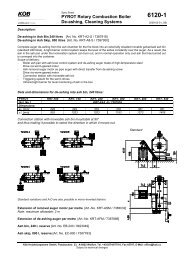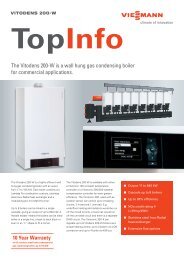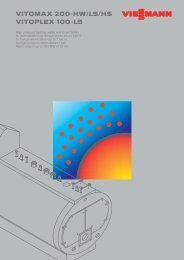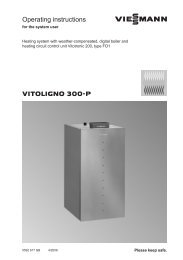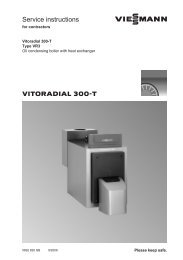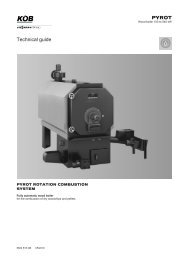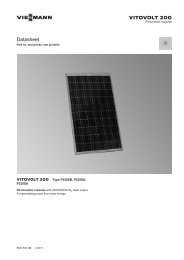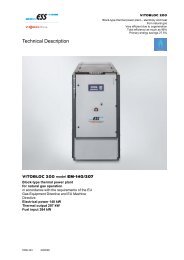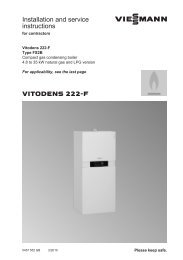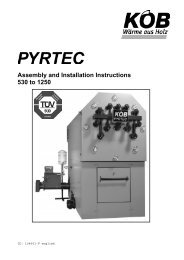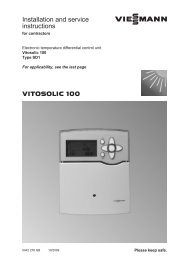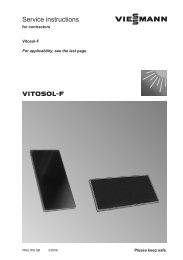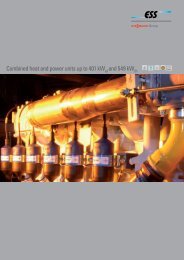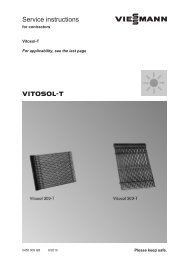Weather Compensation brochure597 KB - Viessmann
Weather Compensation brochure597 KB - Viessmann
Weather Compensation brochure597 KB - Viessmann
Create successful ePaper yourself
Turn your PDF publications into a flip-book with our unique Google optimized e-Paper software.
Control technology<strong>Weather</strong> compensated controlsFind out how to save an amazing 15% extra on fuel bills...with advanced boiler controls from <strong>Viessmann</strong>
<strong>Weather</strong>compensationWith ever increasing fuel bills and the need tobe as eco-friendly as possible, it's importantthat we all look for ways to save fuel andcarbon emissions - and money!All boilers now have to be condensing boilersand this represents a huge step forwardin environmentally friendly heating, withfuel savings of up to 35% compared toconventional boilers.But there is a way to save even more - up to15% in fact, with just a simple outdoor sensorand some very clever <strong>Weather</strong> <strong>Compensation</strong>controls, available with the Vitodens range ofcondensing boilers.For a relatively small investment you'll not onlysave up to 15% more fuel each year but you'llalso enjoy an incredibly comfortable home -with a pleasant indoor temperature - whateverthe weather.Heating - the basicsOur homes need heating, to replace heat lostthrough the walls etc. The colder it is outside,the more heat is lost and the more we haveto heat the building, to replace that heat,especially in the winter when the heat loss isat its highest level.This basic explanation is fundamental tounderstanding how an outdoor weather sensorcan help to heat your home in a more efficientand cost-effective way.<strong>Weather</strong> compensation controls work byensuring that the boiler burns the exactamount of fuel required to match the heat lostfrom the building. The house will always bewarm (at the desired temperature) and willnever be too hot or too cold.<strong>Weather</strong> compensation significantly improvesefficiency under partial load conditions andis especially relevant for the UK climate,as for two thirds of the year the boiler willprovide only a fraction of its maximum heatload, which means the boiler temperature isreduced for the majority of the year, while stillmaintaining a constant room temperature of20ºC. Only around 15% of the homes totalheat energy usage is consumed during wintertemperatures between -3 to -10ºC.Conventional controlsTraditional heating systems have aroom thermostat indoors and this isthe sequence that follows a drop intemperature.1. Outside temperature drops2. More heat is lost throughthe walls & windows3. Rooms get colder - which isdetected by the room thermostat4. Thermostat 'tells' the boilerto come on/work harderIn the above example, it isn't untilstage 4 that the boiler gets any'feedback' and is able to respondto changing conditions. Thechances are that at this stage, thehouseholder will be feeling the coldand will turn the thermostat up evenfurther - wasting even more fuel.If the outside temperature rises,the boiler will not respond until therooms have become uncomfortablywarm - so in addition to adjusting thethermostat, there'll probably be thetemptation to open some windows,releasing more heat and wastingmore energy.With a weather compensationsystem, the boiler is able to respondat stage 1 - see opposite.5. Rooms get warmer again
How does it work?A small temperature sensor is locatedon the outside of the building, on a northfacing wall. This is wired to the internalcontrols of the boiler and information aboutthe outside temperature is sent to the boilercontroller constantly.When the temperature changes outsidethe boiler responds and starts to increaseor decrease the radiator temperature tocompensate. This pro-active mechanismmeans that people inside the building won'teven notice that the temperature haschanged outside.For example, when the outside temperaturedrops at night, more heat is lost throughthe walls of the building. Because theoutdoor sensor detects the fall as soon asit happens, the boiler is able to raise theradiator temperature and keep the insidetemperature stable. With a conventionalsystem, the temperature is dependent on aroom thermostat, which will only take effectafter the inside of the building has becometoo hot or too cold.In summary, weather compensationcontrols enable the boiler to respond tooutside temperature changes and adjustthe radiator output, to maintain a constanttemperature indoors.The boiler flow diagram below helps todemonstrate how this compares to a heatingsystem without weather compensation -where the boiler runs very hot then very coldas it constantly 'plays catch up' to achieve thedesired room temperature.Maximising the condensing effectCondensing boilers have dramaticallyincreased the efficiency of home heatingsystems, by recovering latent heat in the fluegases. For a condensing boiler to achievethe high levels of efficiency it is capable of itneeds to condense for as long as possible.An outdoor weather sensor can help theboiler operate at lower temperatures,meaning it can condense for longer.How does it help the boiler tocondense longer?For a condensing boiler to actually get thewater vapour in the flue gas to condense,the return water temperature needs to be ator below 57ºC (dew point). Without weathersensitive controls this may not be the case,with most boilers operating with a flowtemperature of around 80ºC. This results in areturn temperature of around 70ºC - too highfor condensation to occur.Advanced controls, with an outdoor weathersensor enable the boiler to make constant,small adjustments to the flow temperature,ensuring that the boiler runs as hot as itneeds to - but no hotter. By achieving aflow temperature a few degrees lower,the return temperature is lower, and theboiler condenses for longer, operating moreefficiently and thus saving fuel.Room temperature °C20ºRoom temperature ºC15º10º5ºWith weather compensationWith room thermostat0ºTimeBoiler flow temperature °CBoiler flow temperature ºC80º75º65º55º0ºWith weather compensationWithoutweather compensationTime
Standard weather compensation controls(Vitodens 100 range only)The curve demonstrates how the boilertemperature adjusts in response to changesin the outside temperature.As the heating curve shows, if the outsidetemperature is close to freezing the boilerwill run at a flow temperature of around65ºC, which ensures a return temperatureenabling the boiler to condense. If theoutside temperature increases, the set flowtemperature reduces accordingly, to maintaincomfort and increase fuel savings. In thiscase the slope and shape of the curve arefixed, but it is possible to position (or shift)the heating curve so that the boiler achievesand maintains the preferred temperature ofthe householder. Savings of up to 12% canbe achieved.Advanced weather compensation controls(Vitodens 200 range only)This type of boiler control is very sophisticatedin that the slope of the heating curve can beadjusted or 'fine tuned' to suit not only thehouseholder, but also the type of buildingconstruction.For example a very well insulated house willlose far less heat than an older house andwill not require the boiler to work so hardwhen the outside temperature drops - so aflatter heating curve will achieve the desiredroom temperature for such a building. A badlyinsulated house will experience high heat lossin the winter and require a steeper heatingcurve to compensate.Boiler flow temperature °CBoiler flow temperature ºC908070605040302020 15 10 5 0 -5 -10 -15 -20 -25 -30Outside temperature ºCBoiler flow temperature °CBoiler flow temperature ºC110100908070605040303.43.23.02.82.62.42,22,01,81,61,41,21,00,80,60,40,2Once again the position of the heating curveis set according to the householder's heatrequirement in terms of personal comfort.2015105 0 -5 -10 -15 -20Outside temperature ºCFurther benefits are:Night set-back optionBuilt-in 7-day programmerBuilt-in pump logic for optimised pumpover-run to reduce power consumptionMorning booster function, it lifts the flowtemperature by 20% first thing in themorning to heat the house fasterSavings of up to 15% can be achieved
What does it mean to the householder?Lower fuel bills - save up to 15% of yourannual fuel bill - that's on top of the savingsyou'll make by changing a conventional boilerfor a condensing boiler.A comfortable home - a constanttemperature is maintained inside, despitethe changing weather.You won't even notice the changes -because the system is pro-active, ratherthan reactive, you won't notice the subtletemperature changes. You certainly won't befeeling the cold and don't need to worry aboutadjusting a room thermostat. An even quieterboiler - if you've already got a <strong>Viessmann</strong>boiler, you'll know that they operate incrediblyquietly. With weather compensation the boilershould fire so infrequently that for the firstfew months you'll probably keep checkingit's still on!Cooler radiators - a good sign that theweather compensation is working well, is thatthe radiators will feel warm, but won't getvery hot, then cool. This is because the smalladjustments mean that a steady temperatureis maintained, with few fluctuations.Piping hot water - even though the radiatortemperature is kept low, you have thereassurance that, at the same time, thetemperature of water in the cylinder (if youhave one) is maintained, for piping hot waterwhen required.<strong>Weather</strong> compensation controlsWith weather compensation the sequenceof events changes considerably:1. Outside temperaturedrops/rises - which is detectedby outdoor sensor2. Boiler operates at ahigher/lower temperature*The small, constant adjustmentsmean that the radiators should feelwarm, rather than hot and thencold. In this example, as soon as theoutside temperature falls, the boileris able to respond instantly becausethe sensor is continually sendinginformation to the boiler.If the outside temperature rises,the boiler will automatically run theradiators at a lower temperature,to maintain the correct level. Thehouseholder will be unaware ofthese small constant adjustmentsand does not have to touch anycontrols or thermostats to enjoy aconstant, comfortable temperature.3. Radiators get warmer/lesswarm to compensate forheat lost*4. Room temperatureis maintained
<strong>Viessmann</strong> LimitedHortonwood 30, TelfordShropshire, TF1 7YPTel: 01952 675000Fax: 01952 675040www.viessmann.co.uk<strong>Weather</strong> sensitive controls from<strong>Viessmann</strong><strong>Weather</strong> sensitive controls are availableon most Vitodens domestic boilers - eitheras an optional extra, or already built in.There are 2 versions:Standard weather compensation controlsVitodens 100-W System and Combi modelsare already fitted with standard weathersensitive controls and just need connectingto an outdoor sensor, to take advantage ofsignificant fuel savings. A kit is available forthe Vitodens 100-W Compact.Advanced weather compensationcontrol - the Vitotronic 200This advanced control is available as anoption on the purchase of the Vitodens200-W or Vitodens 222-F boilers. It isfitted as standard in the Vitodens 242-Fsolar DHW storage boiler.Vitotronic 200 controls are highly responsive,for increased efficiency and maximumsavings. There are also a number of addedfeatures for comfort and convenience,including a Party function, which extends theheating period to keep the house warmerwithout having to alter the settings. A Holidaysetting enables you to key in your holidaydates and while you're away the boiler willrun a frost protection program instead of yourcomfort heating settings. It will then warm upthe house before you return. The Economysetting is a quick and easy way to turn thetemperature down if you're leaving the housefor a few hours.Additional features include:Easy installation, commissioning andmaintenance, with integrated diagnosticsService interval displayDigital time switch for selecting daily orweekly programsAutomatic summer/winter change overIntegral control unit for 3 heating circuits(2 mixed, 1 unmixed) and 1 DHW circuitIntegral remote monitoring & operationinterfacesThe graphic display of the new Vitotronic controlunit can also display the solar yield, for exampleFor installers and developersBuilding regulations (SAP) add 3%to the energy calculation if weathercompensation is used.Your trade partner:9443 086 GB 03/2012Copyright <strong>Viessmann</strong>Duplication and alternative use only with prior written consent.Subject to technical modifications.



